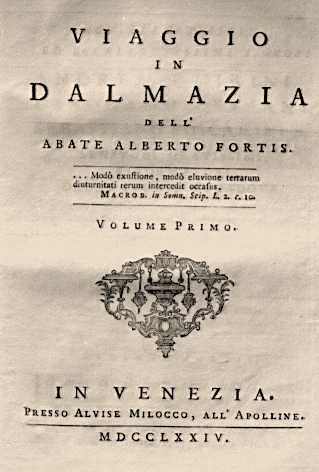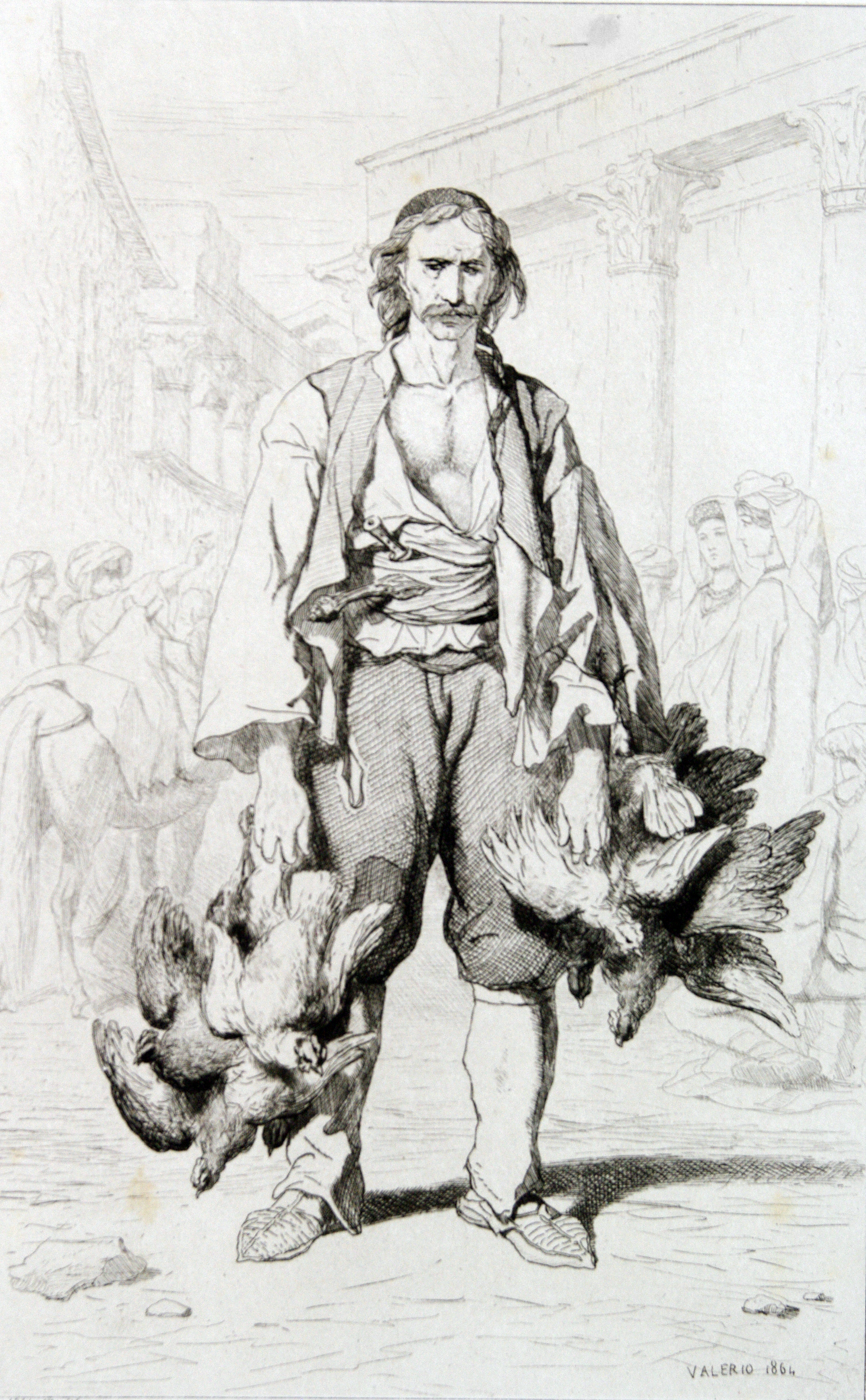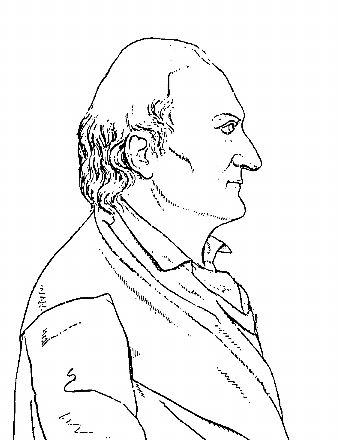|
Morlachism
Morlachism or Morlacchism ( it, Morlacchismo; sh, Morlakizam or ) was a movement in Italian, Ragusan and Venetian literature that started in 1774 and lasted until the 1830s or 1840s. It consisted on the portrayal of the Morlachs (Vlachs from the Dalmatian Hinterland, now part of Croatia) and other inhabitants of Dalmatia and their beliefs, customs, way of living and many other aspects as imagined by Italians, Ragusans, Venetians and other Europeans. Morlachism was initiated by Alberto Fortis's travel book ''Viaggio in Dalmazia'' ("Journey to Dalmatia") from 1774, which achieved great popularity in Western Europe. In 2014, Branislava Milić Brett, then professor at the University of Alberta, coined the term "Proto-Morlachism" (also referred to as "Pre-Morlachism") to refer to a purported earlier stage of Morlachism that lasted from the Middle Ages to 1774. According to her, particularities of Proto-Morlachism include that, unlike Morlachism, it also included interventions and view ... [...More Info...] [...Related Items...] OR: [Wikipedia] [Google] [Baidu] |
Morlachs
Morlachs ( sh-Latn-Cyrl, Morlaci, Морлаци or , ; it, Morlacchi; ro, Morlaci) has been an exonym used for a rural Christian community in Herzegovina, Lika and the Dalmatian Hinterland. The term was initially used for a bilingual Vlach pastoralist community in the mountains of Croatia in the second half of the 14th until the early 16th century. Then, when the community straddled the Venetian– Ottoman border until in the 17th century, it only referred to Slavic-speaking, mainly Eastern Orthodox but also Roman Catholic people. The Vlach i.e. Morlach population of Herzegovina and Dalmatian hinterland from the Venetian and Turkish side were of either Roman Catholic or Christian Orthodox faith. Venetian sources from 17th and 18th century make no distinction between Orthodox and Catholics, they refer to both groupings as Morlachs. The exonym ceased to be used in an ethnic sense by the end of the 18th century, and came to be viewed as derogatory, but has been renewed as a soc ... [...More Info...] [...Related Items...] OR: [Wikipedia] [Google] [Baidu] |
Alberto Fortis
Alberto Fortis (1741–1803) was a Republic of Venice, Venetian writer, naturalist and cartographer. Life His real name was Giovanni Battista Fortis (his religious name was ''Alberto'') and he was born in Padua on either 9 or 11 of November 1741. He journeyed extensively in Venetian Dalmatia. His best known work is ''Viaggio in Dalmazia'' ("Journey to Dalmatia"), originally published in 1774 and first published in London in 1778. The highlight of the book is the description of Morlachia, a historical region currently located in Croatia named after the Morlachs that inhabited the region. In his book, Fortis presented his literary discovery "Hasanaginica" as a Morlach (Vlach) ballad. Larry Wolf believed Fortis wrote the ballad as a poetry of South Slavs rather than a poetry of the Morlachs. Fortis believed that the Morlachs preserved their old customs and clothes. Their ethnographic traits were traditional clothings, use of the gusle musical instrument accompanied with epic singing ... [...More Info...] [...Related Items...] OR: [Wikipedia] [Google] [Baidu] |
Franco Sacchetti
Franco Sacchetti (; c. 1335 – c. 1400), was an Italian poet and novelist. Biography Born in Florence or in Ragusa (Croatia), Ragusa (modern Dubrovnik), he was the son of Benci di Uguccione, surnamed ''"Buono"'', a Florentine merchant of the noble and ancient family of the Sacchetti. He was married three times; first to Maria Felice Strozzi with whom he had two sons, Filippo and Niccolo. Franco’s second wife was Ghita di Piero Gherardini, his third wife was Giovanna di Francesco Bruni. He was the brother of Giannozzo Sacchetti, a follower of Catherine of Siena, who was executed following the Ciompi Revolt. While still a young man he achieved repute as a poet, and he appears to have traveled on affairs of more or less importance as far as to Genoa, Milan and Slavonia. After 1363 he settled in Florence. When a sentence of banishment was passed upon the rest of the house of Sacchetti by the Florentine authorities in 1380 (after the Ciompi revolt) it appears that Sacchetti ... [...More Info...] [...Related Items...] OR: [Wikipedia] [Google] [Baidu] |
Viaggio In Dalmazia
''Viaggio in Dalmazia'' ("Journey to Dalmatia"), also known by its full title ''Viaggio in Dalmazia dell'abate Alberto Fortis'' ("Journey to Dalmatia by Abbot Alberto Fortis"), is a 1774 book by the Venetian writer Alberto Fortis published in the city of Venice. On it, Fortis recounted his journey to Dalmatia, a region now in Croatia. He described the region, its mineral resources and its inhabitants and their way of life, paying great attention to the native Morlachs. Fortis' book reached great popularity in Western Europe and increased the interest on Croatia and other South Slavic countries among ethnologists and anthropologists. Furthermore, ''Viaggio in Dalmazia'' would start a new movement in Italian, Ragusan and Venetian literature known as Morlachism, which consisted on the portrayal of the Morlachs and their customs, traditions and lifestyle by Italian and other Western European writers. This movement started in 1774 and lasted until the 1830s or 1840s. In 1776, the C ... [...More Info...] [...Related Items...] OR: [Wikipedia] [Google] [Baidu] |
Ragusan Literature
hr, Sloboda se ne prodaje za sve zlato svijeta it, La libertà non si vende nemmeno per tutto l'oro del mondo"Liberty is not sold for all the gold in the world" , population_estimate = 90 000 in the XVI Century , currency = Ragusa perpera and others , common_languages = , title_leader = Rector as Head of state , leader1 = Nikša Sorgo , year_leader1 = 1358 , leader2 = Sabo Giorgi , year_leader2 = 1807-1808 , today = CroatiaBosnia and HerzegovinaMontenegro , footnotes = A Romance language similar to both Italian and Romanian. While present in the region even before the establishment of the Republic, Croatian, also referred to as ''Slavic'' or ''Illyrian'' at the time, had not become widely spoken until late 15th century. The Republic of Ragusa ( dlm, Republica de Ragusa; la, Respublica Ragusina; it, Repubblica di Ragusa; hr, Dubrovačka Republika; ... [...More Info...] [...Related Items...] OR: [Wikipedia] [Google] [Baidu] |
18th-century Literature
Literature of the 18th century refers to world literature produced during the years 1700–1799. European literature in the 18th century European literature of the 18th century refers to literature (poetry, drama, satire, and novels) produced in Europe during this period. The 18th century saw the development of the modern novel as literary genre, in fact many candidates for the first novel in English date from this period, of which Daniel Defoe's 1719 ''Robinson Crusoe'' is probably the best known. Subgenres of the novel during the 18th century were the epistolary novel, the sentimental novel, histories, the gothic novel and the libertine novel. 18th century Europe started in the Age of Enlightenment and gradually moved towards Romanticism. In the visual arts, it was the period of Neoclassicism. The Enlightenment The 18th century in Europe was the Age of Enlightenment, and literature explored themes of social upheaval, reversals of personal status, political satire, geo ... [...More Info...] [...Related Items...] OR: [Wikipedia] [Google] [Baidu] |
Karelianism
Karelianism was a late 19th-century cultural phenomenon in the Grand Duchy of Finland and involved writers, painters, poets and sculptors. Since the publishing of the Finnish national epic Kalevala in 1835, compiled from Finnish and Karelian folk lore, culture spheres in Finland became increasingly curious about Karelian heritage and landscape. By the end of the 19th century Karelianism had become a major trend for many works of art and literature in Finland. In the movement Karelia was seen as a sort of refuge for the essence of "Finnishness" that had maintained its authenticity across centuries. The phenomenon can be interpreted as a Finnish version of European national romanticism. The painters Akseli Gallen-Kallela and Louis Sparre are usually mentioned as the founders of the movement. They were soon joined by the sculptor Emil Wikström, the writers Juhani Aho, Eino Leino and Ilmari Kianto, the composers Jean Sibelius and P.J. Hannikainen, the architects Yrjö Blomstedt and ... [...More Info...] [...Related Items...] OR: [Wikipedia] [Google] [Baidu] |
Middle Ages
In the history of Europe, the Middle Ages or medieval period lasted approximately from the late 5th to the late 15th centuries, similar to the post-classical period of global history. It began with the fall of the Western Roman Empire and transitioned into the Renaissance and the Age of Discovery. The Middle Ages is the middle period of the three traditional divisions of Western history: classical antiquity, the medieval period, and the modern period. The medieval period is itself subdivided into the Early, High, and Late Middle Ages. Population decline, counterurbanisation, the collapse of centralized authority, invasions, and mass migrations of tribes, which had begun in late antiquity, continued into the Early Middle Ages. The large-scale movements of the Migration Period, including various Germanic peoples, formed new kingdoms in what remained of the Western Roman Empire. In the 7th century, North Africa and the Middle East—most recently part of the Eastern Ro ... [...More Info...] [...Related Items...] OR: [Wikipedia] [Google] [Baidu] |
University Of Alberta
The University of Alberta, also known as U of A or UAlberta, is a public research university located in Edmonton, Alberta, Canada. It was founded in 1908 by Alexander Cameron Rutherford,"A Gentleman of Strathcona – Alexander Cameron Rutherford", Douglas R. Babcock, 1989, The University of Calgary Press, 2500 University Drive NW, Calgary, Alberta, Canada, the first premier of Alberta, and Henry Marshall Tory,"Henry Marshall Tory, A Biography", originally published 1954, current edition January 1992, E.A. Corbett, Toronto: Ryerson Press, the university's first president. It was enabled through the Post-secondary Learning Act''.'' The university is considered a "comprehensive academic and research university" (CARU), which means that it offers a range of academic and professional programs that generally lead to undergraduate and graduate level credentials. The university comprises four campuses in Edmonton, an Augustana Campus in Camrose, and a staff centre in downtown Cal ... [...More Info...] [...Related Items...] OR: [Wikipedia] [Google] [Baidu] |
Fortis Viaggio In Dalmazia
Fortis may refer to: Business * Fortis AG, a Swiss watch company * Fortis Films, an American film and television production company founded by actress and producer Sandra Bullock * Fortis Healthcare, a chain of hospitals in India * Fortis Inc., a Canadian utility holding company * Fortis Group, a defunct banking, financial services, and insurance company, based in Belgium and The Netherlands or their successors: ** Ageas, formed from the insurance operations of Fortis ** ASR Nederland, formed from the Dutch insurance operations of Fortis ** BNP Paribas Fortis, formed from the Belgian banking operations of Fortis, now owned by BNP Paribas ** ABN AMRO, formed from the Netherlands banking operations of Fortis, now owned by the Dutch government People * Alberto Fortis (1741–1803), Venetian writer, naturalist and cartographer * Alberto Fortis (musician) (born 1955), Italian singer and songwriter * Alessandro Fortis (1842–1909), Italian politician and prime minister * Jean-Bap ... [...More Info...] [...Related Items...] OR: [Wikipedia] [Google] [Baidu] |
Travel Book
The genre of travel literature encompasses outdoor literature, guide books, nature writing, and travel memoirs. One early travel memoirist in Western literature was Pausanias (geographer), Pausanias, a Greek geographer of the 2nd century CE. In the early modern period, James Boswell's ''Journal of a Tour to the Hebrides'' (1786) helped shape travel memoir as a genre. History Early examples of travel literature include the ''Periplus of the Erythraean Sea'' (generally considered a 1st century CE work; authorship is debated), Pausanias (geographer), Pausanias' ''Description of Greece'' in the 2nd century CE, ''Safarnama'' (Book of Travels) by Nasir Khusraw (1003-1077), the ''Itinerarium Cambriae, Journey Through Wales'' (1191) and ''Descriptio Cambriae, Description of Wales'' (1194) by Gerald of Wales, and the travel journals of Ibn Jubayr (1145–1214), Marco Polo (1254–1354), and Ibn Battuta (1304–1377), all of whom recorded their travels across the known world ... [...More Info...] [...Related Items...] OR: [Wikipedia] [Google] [Baidu] |
Italian Literature
Italian literature is written in the Italian language, particularly within Italy. It may also refer to literature written by Italian people, Italians or in Languages of Italy, other languages spoken in Italy, often languages that are closely related to Italian language#History, modern Italian, including Regional Italian, regional varieties and vernacular dialects. Italian literature begins in the 12th century, when in different regions of the Italian Peninsula, peninsula the Italian vernacular started to be used in a literary manner. The ''Salv'a lo vescovo senato, Ritmo laurenziano'' is the first extant document of Italian literature. An early example of Italian literature is the tradition of vernacular lyric poetry performed in Occitan language, Occitan, which reached Italy by the end of the 12th century. In 1230, the Sicilian School became notable for being the first style in standard Italian. Dante Alighieri, one of the greatest of Italian poets, is notable for being the aut ... [...More Info...] [...Related Items...] OR: [Wikipedia] [Google] [Baidu] |



.jpg)



